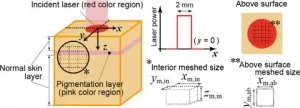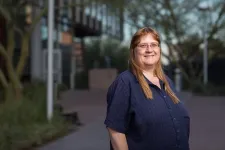(Press-News.org) Researchers from Skoltech have developed an early prototype of a medical imaging system that uses neural networks to analyze near-infrared images of veins and project a venous pattern onto a patient's body - this may make blood draws much easier and less of a nuisance for patients with difficult access to veins. The paper was published in the proceedings of the 16th International Conference on Control, Automation, Robotics and Vision (ICARCV).
According to data cited in the paper, out of approximately 20 million blood tests performed globally every day, almost 45% are estimated to involve some degree of discomfort for the patient whose veins are harder to access due to medical conditions such as diabetes, a particularly young age, or simply individual characteristics of the body. In these cases, when veins are hardly discernible and non-palpable, even experienced medical professionals have to turn to technical aids or risk multiple or inaccurate punctures, which can even have health consequences, especially for older adults.
Dmitry Dylov, Associate Professor at the Center for Computational and Data-Intensive Science and Engineering (CDISE) and the head of Computational Imaging Group at Skoltech, and his colleagues decided to assemble an intelligent near-infrared vein scanner, which can determine vein contours in an arm or a leg quite accurately, fully automatically, and independently (without any input from the user). They did so by using artificial neural networks and reinforcement learning to better analyze the images and project them back as a visual aid onto the patient's body, adjusting for its shape and position.
"Infrared vein scanners have become commonplace in clinical practice. However, this is the first one that does everything entirely by virtue of modern AI: one neural network cleans and processes the infrared signal, the second one detects contours of the veins, and the third one continuously 'worries' about alignment to assure the contours projected to a patient's arm overlap with the actual veins. Remarkably, all we had to do was to tell the system what is good and what is bad during the training stage, and the neural networks managed to learn the rest by themselves, automatically finding optimal settings for new patients, environments, and even distortions, even if the system has never encountered them," Dmitry Dylov says.
Vito Leli, Skoltech PhD student and the lead author of the published work, notes there are many factors hindering the detection of veins even in the infrared range where the vein contrast is better. "So the instrument was posed to face mostly the algorithmic and the image-processing challenges. We wanted to account for the high variability of the contrast of vasculature among patients (e.g., due to skin tone and thickness, etc.). Our final algorithm is also capable of vasculature detection even for low signal-to-noise ratios (SNR), as validated on a cohort of patients," he adds.
The team assembled a prototype device and tested it in experiments with volunteers, showing it was able to detect the venous pattern in the near-infrared spectrum and then project it back as an image onto people's arms. "Forearms are body parts usually used for blood tests so it was our natural decision to develop a system able to solve the problem of visualizing veins in that specific area. Nothing stops us from using it to image vasculature in other areas needed for other clinical applications, e.g., to assist with installation of a catheter. The gadget is rather compact and flexible for that. As the first step in our research, we collected and NIR forearm's images from the volunteers in Skoltech to train our device and taking photos of forearms is more privacy-friendly than face shots," Alexander Sarachakov, MSc student and coauthor of the paper, says.
A blood test performed with this device would look like this: the patient puts her arm under the device, which immediately searches for veins (in less than a second) and projects them over the forearm. "If the patient moves the forearm, although we do not recommend it during a blood test involving needles, the system will immediately start the realigning procedure," Sarachakov explains.
"The proposed imager can be scaled to other body parts in clinics (for example, facial and leg vessels) and for veterinarian care to aid with complex venipuncture in animals. We stress that we aspired to build an inexpensive hardware configuration, opposite to the existing offerings in the market. Our networks are also made light and flexible for embedding them into existing off-the-shelf controllers," the authors conclude in the paper.
"We are currently working on automatic selection of the best combinations of denoising and segmentation models to make the images cleaner and thus to obtain even better vein recognition. The questions we ask ourselves is how low of the SNR we could work with so that we both check some fundamental limits of the algorithms and also can work with for some inexpensive hardware components. Speaking of which, we are about to start testing the second generation of our hardware prototype which will bring us closer towards the product launching. It is fascinating to work on the border between fundamental science and immediate engineering realization," Oleg Rogov, research scientist and coauthor of the paper, concludes.
INFORMATION:
(Boston)--Pregnancy complications affect up to one in three pregnancies and are increasingly linked to future chronic disease. For example, preeclampsia is associated with a doubled risk of cardiovascular disease, the leading cause of death in the U.S., and gestational diabetes is associated with a seven-fold increased risk of type 2 diabetes. While guidelines recommend preventive care starting within the first postpartum year to address such pregnancy-related health risks, the connections between pregnancy health and future health are often neglected.
In ...
An international team of researchers led by a University of Virginia School of Medicine professor is warning that scientists must better prepare for the next pandemic - and has developed a plan to do just that.
Noting the "avalanche" of scientific data generated in response to COVID-19, UVA's Wladek Minor, PhD, and colleagues are calling for the creation of an "advanced information system" (AIS) to help scientists integrate, monitor and evaluate the vast amounts of data that will be produced as researchers reveal the molecular architecture of the next pathogen ...
URBANA, Ill. - Ever thought about buying or building a bat box to help bats? Think carefully about the design and where you put it, University of Illinois researchers say.
Here's why: Bats and their pups can overheat and die in poorly designed or placed bat boxes, and in a warming climate, it could happen more often.
Illinois bat ecologists Joy O'Keefe and Reed Crawford recently synthesized the available data on bat boxes, also known as bat houses or artificial roosts, to raise awareness of the issue and motivate change in bat box design, marketing, and consumer education. Their recommendations are published in Conservation Science and Practice.
"Conservation ...
A pilot human clinical trial conducted by researchers at Baylor College of Medicine reveals that supplementation with GlyNAC - a combination of glycine and N-acetylcysteine as precursors of the natural antioxidant glutathione - could improve many age-associated defects in older humans to improve muscle strength and cognition, and promote healthy aging.
Published in the journal Clinical and Translational Medicine, the results of this study show that older humans taking GlyNAC for 24 weeks saw improvements in many characteristic defects of aging, including ...
In the Arctic, climate change and pollution are the biggest threats to top predators like narwals. Studying the animals' tusks reveals that diet and exposure to pollution have shifted over the past half century in response to sea-ice decline. Human emissions have also led to a sharp rise in the presence of mercury in recent years, according to an international team of researchers.
"Our research shows that climate change is having substantial impacts on Arctic ecosystems, with consequences for exposure to toxic pollutants like mercury," says co-author Jean-Pierre Desforges, a Postdoctoral Fellow at McGill University under the supervision ...
Alexandria, Va., USA -- Asymptomatic carriage of SARS-CoV-2 is a potentially significant source of transmission, yet remains relatively poorly understood. The study "SARS-CoV-2 Positivity in Asymptomatic-screened Dental Patients" published in the Journal of Dental Research (JDR), investigated SARS-CoV-2 infection in asymptomatic dental patients to inform community surveillance and improve understanding of risks in the dental setting.
Thirty-one dental care centers across Scotland invited asymptomatic screened patients over the age of five to participate. During the patient visit, trained ...
Laser treatment is now commonplace across various fields of medicine including dermatology, where it is commonly used to remove scars, wrinkles, and freckles. The technology, however, has a major downside: despite continued improvements, medical accidents related to laser treatment has been on the rise, with studies revealing excessively high laser energy as the major cause of such accidents.
Assistant Professor Takahiro Kono from Shibaura Institute of Technology (SIT), Japan, whose research is focused on the mechanism of heat transfer involved in the interaction of laser light with biological tissue explains, "The difficulty lies in adjusting the laser conditions for each patient ...
A team of researchers led by UCL Great Ormond Street Institute of Child Health (ICH) and Great Ormond Street Hospital (GOSH) has found that metformin - a drug commonly used to treat Type 2 diabetes - can successfully reduce symptoms associated with tuberous sclerosis complex (TSC), including reduction in the frequency of seizures and the size of brain tumours.
The study, which also included teams from Royal United Hospitals Bath NHS Foundation Trust (RUH) and University Hospitals Bristol and Weston NHS Foundation Trust, recruited 51 patients with TSC who were randomly assigned a placebo or metformin for one year on a dose similar to that given for Type 2 diabetes.
TSC is a genetic disorder characterised ...
In order to develop more effective drugs against a range of cancers, researchers have been investigating the molecular structure of many diseased-linked enzymes in the body. An intriguing case in point is Taspase 1, a type of enzyme known as a protease. The primary duty of proteases is to break down proteins into smaller peptide snippets or single amino acids.
Taspase 1 appears to play a vital role in a range of physiological processes, including cell metabolism, proliferation, migration and termination. The normal functioning of Taspase 1 can go awry however, leading to a range of diseases, including leukemia, colon and breast cancers, as well as glioblastoma, a particularly lethal and incurable malignancy in the brain.
Because Taspase 1 dysregulation is increasingly ...
Use of vouchers and coupons offered by pharmaceutical companies to defray patients' out-of-pocket drug costs is concentrated among a small number of drugs. While these offsets significantly reduce patient costs, they are not targeted to patients who most need the price reduction, according to a study from researchers at the Johns Hopkins Bloomberg School of Public Health.
The researchers, in what is thought to be the largest study of its kind to date, analyzed tens of millions of pharmacy transactions by more than 600,000 people in the U.S. during 2017-19, in order to get a better sense of how vouchers and other point-of-sale copayment "offsets" are used. These coupons and vouchers come in many forms--some are offered online directly to customers, others by pharmacy ...



